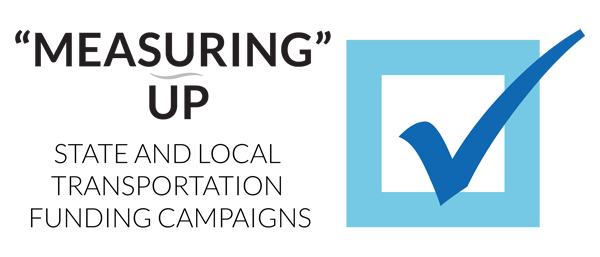Recent State Legislation Allowing for More Local Transportation Funding
-> Next primer: read about the hallmarks of successful ballot measure campaigns
As Congress has proven unwilling to raise new transportation revenue and reform an outdated federal transportation program structure, state and local leaders have increasingly stepped up with new ways to fund transportation. In the past two years, more than two-thirds of the states have pursued legislation to increase state and local funding for transportation. Notably, many state legislatures are extending additional authority and funding to local governments through legislation enabling local option taxes and sub-allocation of certain state funds. For instance, in the past two years Minnesota and Pennsylvania created new provisions allowing counties to levy vehicle fees, Virginia increased taxes dedicated to transportation and sub-allocated the new funding to regional governments, and Indiana allowed counties to use local income tax funds for transit. In all, at least twelve states passed laws dedicating new money or new taxing authority to local governments. More detailed descriptions of several bills considered and enacted are included below.
Yet even as state legislatures have expanded the available funding for local governments, many have placed specific restrictions on how new funds can be spent. For example, the Indiana law prohibits new local tax funds from being used to construct or operate light rail transit. Similarly, the Virginia law limits new funding in the Hampton Roads region to use in road, bridge and tunnel projects. In contrast, Colorado’s legislature allowed for the diverse transportation needs of different regions by allowing cities and counties to use a portion of the state fuel tax funds they receive for transit, pedestrian and bicycle projects needed to integrate a multimodal system.
Local funding works best when local leaders can direct funds to the most needed projects and can partner with state and the federal government. Local leaders are best able to determine the needs of their city, county or region and choose transportation projects that will ease congestion, clear bottlenecks, and allow goods to flow freely and workers to access jobs. Local transportation choices allow for innovation and progress. However, local funding cannot be made to replace federal and state funding. Local governments need strong partnerships with the federal government and their state government to succeed.
Examples of recent state legislation
States vary widely in the funding types they allow local governments to pursue. The accompanying data and maps in the left sidebar show current authorization for different local funding sources and recent legislative activity for different funding types either levied at the local level or raised at the state level and sub-allocated to local governments.
The illustrative examples below explain some of the ways state legislatures are expanding different funding types (click a tab):
The Virginia transportation funding package enacted in 2013 raised both state and local funds from a variety of sources. The act switched the state’s per-gallon gas tax to a percentage tax on gas and an increase of the statewide general sales tax. In the state’s two largest urban regions it additionally it raised the general sales tax by 0.7% and raised other taxes including the gas tax and hotel tax. Additional revenues from these regions are directed to transportation projects in these regions. In Northern Virginia, 30% of the funding is given to local jurisdictions for transportation projects and 70% is directed by the regional transportation board. In Hampton Roads, the funds go to the regional transportation planning board to be directed to regional road, bridge and tunnel projects.
A Nevada law passed in 2013 will allow Clark County (the county containing Las Vegas and the largest in the state) to increase local fuel taxes and index the tax rates to inflation through 2016. The law requires any additional tax increase imposed after 2016 be approved by a voter referendum. Nevada law had already allowed certain counties to levy a county fuel tax.
South Carolina’s legislature considered a bill allowing counties to enact a local option fuel tax of up to $0.02 per gallon. Such a tax would need to by approved by the county government and by voter referendum and revenues could be used for road projects in the county. The bill is currently stalled in a House committee.
A bill passed by Minnesota’s legislature in 2013 expands counties’ ability to impose a “wheelage tax,” a fee on vehicles registered in the county. The bill expanded the taxing authority from just the metropolitan Twin Cities counties to all counties in the state and increased the fee from $5 to $10 in 2014 and up to $20 in 2017. Forty-seven counties in Minnesota currently impose the fee, which is used to fund highway projects in the county.
This year South Dakota’s legislature considered legislation that would allow counties to raise property taxes to fund transportation. It would have removed an existing provision that such county revenues can be used only to match federal transportation dollars. Accompanying legislation would have given counties more leeway to raise property taxes in line with inflation.
A bill passed this year in Indiana would allow six counties in the Indianapolis region to increase local income tax rates by between 0.1% and 0.25% and dedicate these additional revenues to transit. The tax increases will need to be approved by county voter referendum. The bill contains a provision to allow adjoining municipalities to increase taxes and join the transit district by local referendum if the county- wide vote in their county fails. The legislation also mandates that 25% of the transit system’s revenue come from fares and 10% of revenue is supported by business contributions through a non-profit organization.
-> Next primer: read about the hallmarks of successful ballot measure campaigns






